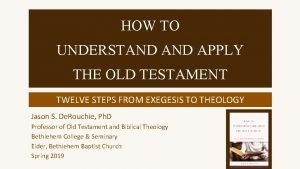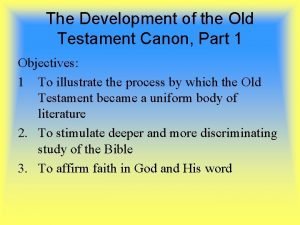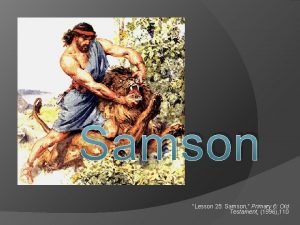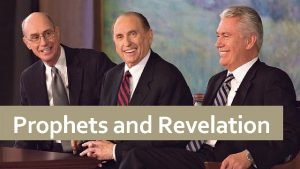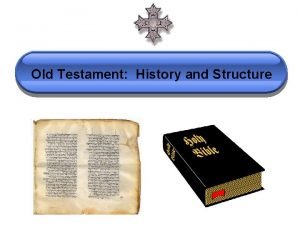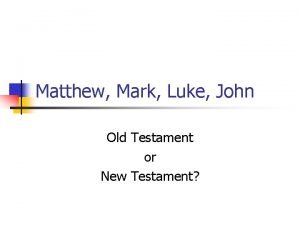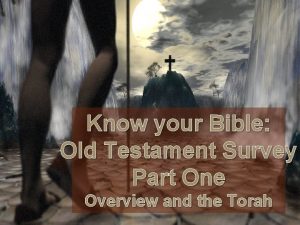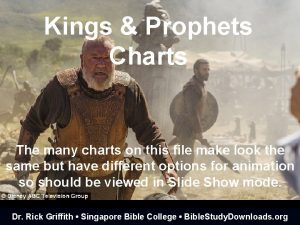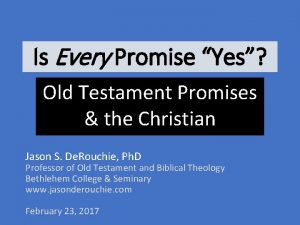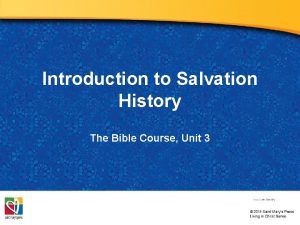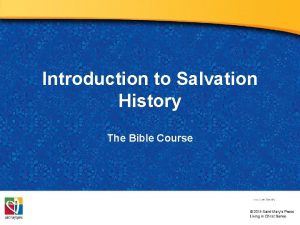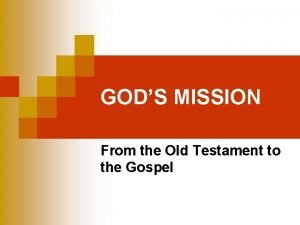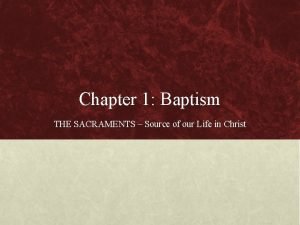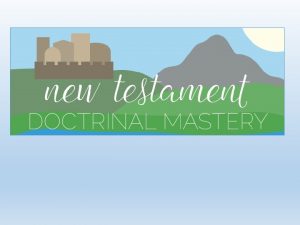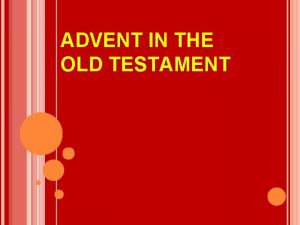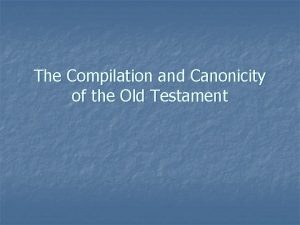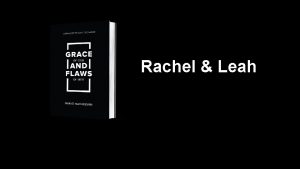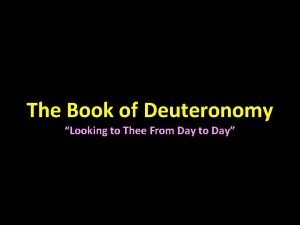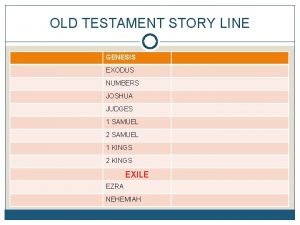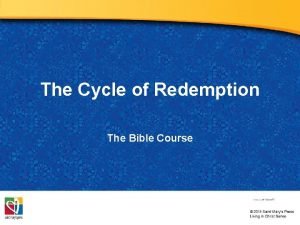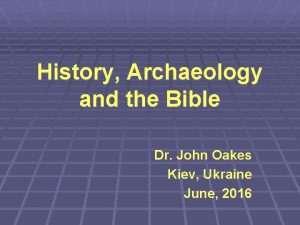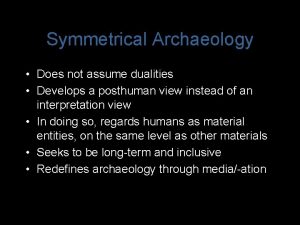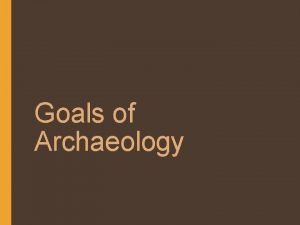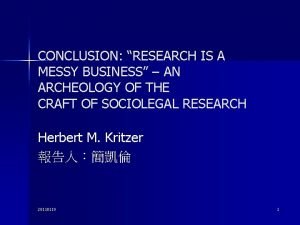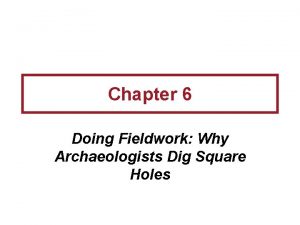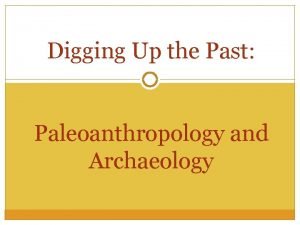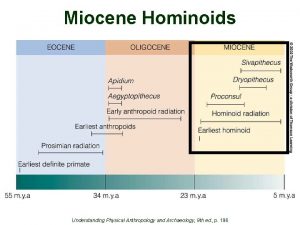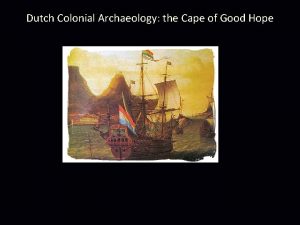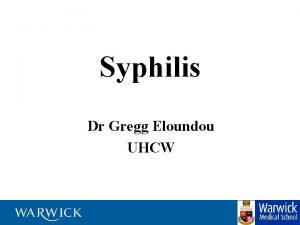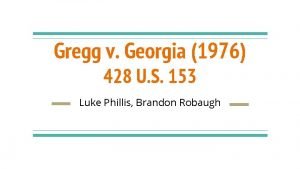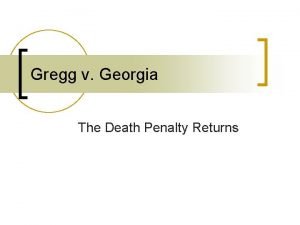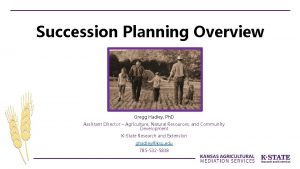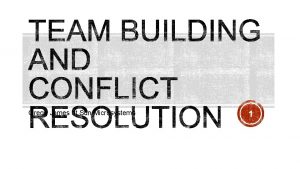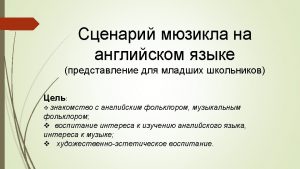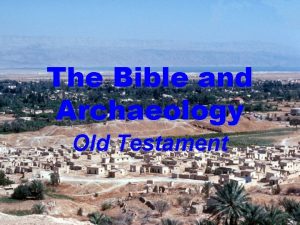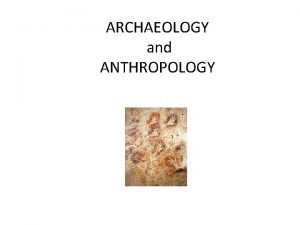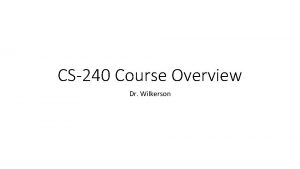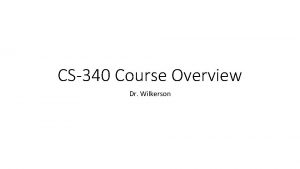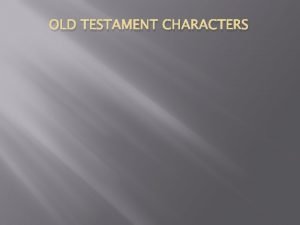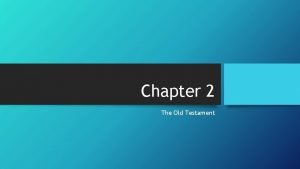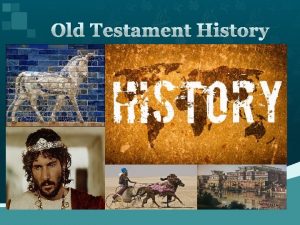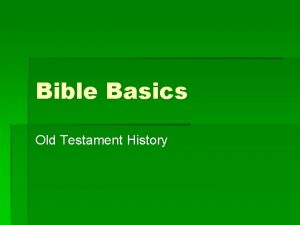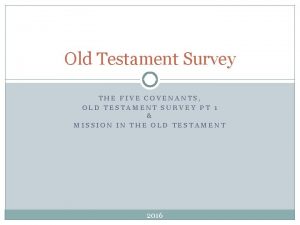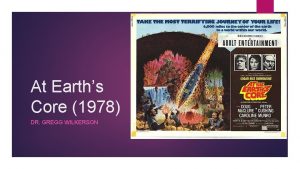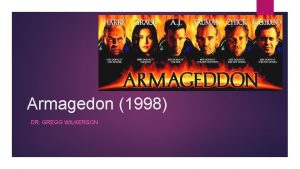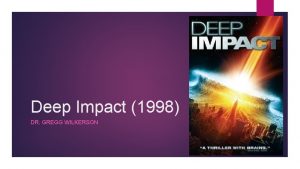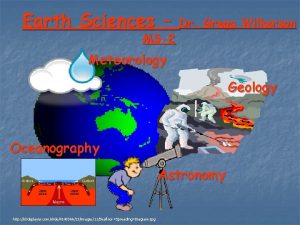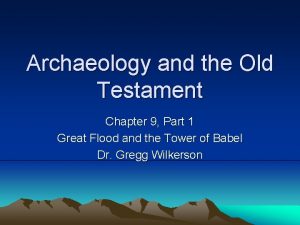Archaeology and the Old Testament Dr Gregg Wilkerson


































































- Slides: 66

Archaeology and the Old Testament Dr. Gregg Wilkerson Chapter 3 Textural Criticism

Textural Criticism • Identify what the original texts said and what they meant to their original audiences. • The term is not meant to have a connotation of people criticizing God’s Word • The processes of textural criticism may seem irreverent to some people

Translations of the Hebrew Bible • Samaritan about 400 BC • Greek Septuagint (by Egyptian scholars under Ptolemy) about 250 BC • Greek and Hebrew was translated into Syriac and Latin about 150 AD. • Hebrew scriptures were translated into Aramaic about 150 AD

SAMARITAN PENTATEUCH (MODERN)

Translations of the Hebrew Bible • Coptic version about 150 AD • Jerome’s Vulgate version (into Latin) in 4 th century is basis for the Catholic Bible • In 500 to 1645 AD the Masorites copied their received text and that translation forms the basis for most of our Old Testament today

Contemporary written record of the Old Testament • Gen 5: 1 -- written account of Adam's line ("book of the generations of Adam") • Ex 24: 4 -- Moses wrote down all the words of the lord • Ex 32: 16 --The tablets were the handiwork of God, and the writing was God's writing. • Ex 34: 1 -- I [God] will write on the tablets

Contemporary written record of the Old Testament • Num. 21: 14 -- the Book of the Wars of the Lord • Deut. 6: 9 -- write them [the laws] on doorframes • Deut. 27: 1 -10 --. . . set up large stones and plaster them. . . write all the words of this law. . . and you shall write upon these stones all the words of this law very plainly

Contemporary written record of the Old Testament • Early “scriptures” are said by some liberal scholars have been “retrofited” by later editors to describe literary activity that in did not really occur until many centuries later. • Putting “books” (Gen 3: 1) in the hands of the patriarchs gave that history an authenticity it did not deserve

Written vs Oral Traditions • Patriarchs were literate in many languages • Several writing mediums existed in the time of the Patriarchs (cuneiform, hieroglyphics) • Merging of oral and written traditions: Prologue to Ecclesiasticus (circa 200 BC) where the grandson of Jesus Bar Sirach says “It is the duty of those who study the scriptures not only to become expert themselves, but also to use their scholarship for the benefit of the outside world through both the spoken and written word. ”

COMPARATIVE TEXTS REVEAL ERRORS IN COPYING • Parallel passages with minor differences -- II Sam 22 vs Psalm 18: David’s song of deliverance from Saul -- Psalm 14 vs Psalm 53: The Impious Fool -- Isaiah 36 -39 vs II Kings 18: 13 to 20: 19: Jerusalem delivered from Sennecherib

COMPARATIVE TEXTS REVEAL ERRORS IN COPYING • These textural differences indicate that errors crept into one (or both) of the passages, because they are different, and (presumably) had the same original source

CHANGES MADE IN TEXT BY SCRIBES: Ish-bosheth • Saul’s son • II Sam 2: 8, he is called Ish-bosheth, "Man of Shame. " (late name) • I Chron 8: 33, he is called Esh Baal, "Man of Baal. " (original name) Why? Baal is a chief pagan deity. Saul worshiped both Yahweh and pagan deities. Later scribes didn’t want to associate Saul’s son with Baal worship.

CHANGES MADE IN TEXT BY SCRIBES: Genesis 1. 9 • The Septuagint (LXX) and Dead Sea Scroll fragment 4 QGen-k agree that this verse should read: “And God said ‘Let the water below the sky be gathered into one area, and let the dry land appear and it was so. And the waters below the heavens gathered into their gathering place and the dry land appeared. ’” • The Masoritic Text (MT) reads: “God said, “Let the water below the sky be gathered into one area, that the dry land may appear. ’”

LXX and 4 QGen-k: “And God said ‘Let the water below the sky be gathered into one area, and let the dry land appear and it was so. And the waters below the heavens gathered into their gathering place and the dry land appeared. ’” MT: God said, “Let the water below the sky be gathered into one area, that the dry land may appear. ’”

CHANGES MADE IN TEXT BY SCRIBES: Genesis 1: 9 • Sometime between the Dead Sea Scrolls and recording of the Masoritic text, one line of scripture was omitted from Genesis 1: 9.

CHANGES MADE IN TEXT BY SCRIBES: Exodus 1: 3 • The Dead Sea Scroll fragment 4 QExod-b for Exodus 1: 3 says that Issachar, Zebulin, Joseph and Benjamin went to Egypt with Jacob. • Sometime after the Dead Sea Scroll was written, another scribe dropped Joseph from the list, because he was already in Egypt when Jacob’s family went there


CHANGES MADE IN TEXT BY SCRIBES: Deuteronomy 32: 8 • The Dead Sea Scroll fragment 4 QDeut-j has polytheistic overtones: “. . . [according to the number] of the sons of God. ” • The Masoritic text (MT) relates a more palatable, “according to the number of the sons of Israel”


CHANGES MADE IN TEXT BY SCRIBES: Deuteronomy 32: 8 • Sometime between the Qumran scrolls manufacture (100 BC-100 AD), and the Leningrad Codex (1008 AD), the text was changed to wash away possible polytheistic interpretation

CHANGES MADE IN TEXT BY SCRIBES: Judges 6: 6 -11 • Dead Sea Scroll fragment 4 QJudga • Compare to MT of Judges 6 • MT is much longer with a prophetic pronouncement reminding the Israelites of warnings during the Exodus

The Masoretic Text of Judges 6 is much longer than the version found among the Dead Sea Scrolls

SEPTUAGINT AND VULGATE TRANSLATIONS BETTER THAN THE MASORETIC TEXT: 1 Samuel 14: 41 The Masoretic text (MT) for this verse is given in ALL CAPITALS: AND SAUL SAID TO THE LORD, GOD OF ISRAEL, "Why hast thou not answered thy servant today? If the guilt be in me or Jonathan my son, O Lord of Israel, give Urim, but if the guilt be in the people of Israel GIVE THUMMIM. JONATHAN AND SAUL WERE TAKEN, AND THE PEOPLE ESCAPED.

SEPTUAGINT AND VULGATE TRANSLATIONS BETTER THAN THE MASORETIC TEXT: 1 Samuel 14: 41 The Masorites left part of the verse out. This is an example of "homoioteleutos", the scribe’s eye skipped the part of the phrase between the word "Israel"

SEPTUAGINT AND VULGATE TRANSLATIONS BETTER THAN THE MASORETIC TEXT: Book of Jeremiah

THE SEPTUAGINT (LXX) VERSION OF JEREMIAH IS 20% LONGER THAN THE MASORETIC TEXT (MT)

EXAMPLE OF A VARIANT DEAD SEA SCROLL READING LEADING TO A BAD TRANSLATION: New English Bible translation of Isaiah 53: 9 • King James version “And he made his grave with the wicked, and with the rich in his death" • New International version "His grave was assigned to be with wicked men (i. e. in a common grave with the criminals with whom he was crucified), but he was with a rich man in his death" • Jesus was buried in a rich man's tomb (Nicodemus). Isaiah 53: 9 is a prophecy fulfilled in Christ. • New English Bible (1970), based on a variant reading of the Dead Sea Isaiah Scroll, translates as follows: "He was assigned a grave with the wicked, a burial place among the refuse of mankind“ TRANSLATION BASED ON VARIANT DSS NEGATES PROPHETIC IMPORTANCE OF THE VERSE

RECENT TRANSLATION "EMENDING" I. E. CHANGING THE TEXT: Phillips translation of I Cor. 14: 22 • Phillips: "tongues are a sign of God's power, not for those who are unbelievers, but for those who already believe. “ • Opposite of what the received text says: “confusing “tongues are. . . not for. . believers” • EMENDING is performed by translators as a last resort, when all attempts to make sense of a text fail

• "we either have a slip of the pen on Paul's part, or more likely, a copyist's error. " • Emendation is logical and consistent with the rest of the passage in 1 Cor. 15. • Contrary to dogma and doctrine about the infallibility and unchangeability of scripture. • Most translations keep the “traditional”, illogical and confusing “tongues are. . . not for…believers”. • Emendations, like this one, were commonly made to the Old Testament texts in antiquity.

Emending of Gen. 3: 16 by Bledstein (1993) • J (Yahwist) writer was a woman. • J text of Gen 3: 16 was corrupted. • Comparison to Gen 4: 7, shifting of one letter (tesuqa) • changes the meaning of the verse to "You are attractive to your man; yet he can rule over you".

• Traditional translation is: “Your desire is for the man and he will rule over you. ” • Thus the art of textural criticism can reverse or invert the traditional reading of a text

SIMILARITY OF APPEARANCE AND COPY ERRORS • Some Hebrew letters look similar. Sloppy copying or poor preservation result in loss of the original text, and changes of meaning.

D (Dalet) and R (Resh)

B (Bet) and K/KH (Kaf)

H (Hey) and CH (Chet)

MULTIPLE VOCALIZATIONS • a single letter can have multiple sounds. • In Hebrew there are two "K" sounds, three "S" sounds, and two "T" sounds. • The change in vocalization, when spelling remains the same, lead to changes in meaning can lead to erroneous translation of the original text.

CHANGE IN PRONUNCIATIONS • Historic word pronunciations changed through time, as well as local dialect variations, leading to some copying "errors". • English example: "Auld Lang Syne" a popular Scottish folk tune composed in 1796

Should acquaintance be forgot and never brought to mind? Should acquaintance be forgot, And auld lang syne. (old) (Old long since or long ago)

• We twa hae paidl'd in the burn, (we two have paddled in the brook) • Frae morning sun till dine; From. . . dinner time • But seas between us braid hai roar'd, (broad have) • Sin auld land syne. (Since old long ago since)

Rapid change in language and errors in transmission • Scottish English from 200 years ago is almost impossible for us to read today • Imagine the differences in Hebrew tradition from the time of the Patriarchs to the Exile (2200 years)

RECOVERED PORTION OF BOOK OF SAMUEL • The Masoritic text is missing some information in the text of 4 QSAM found among the Dead Sea Scrolls



RECOVERED PORTION OF BOOK OF SAMUEL • MT suggests that Nachash had terms of surrender that violated international law of that time (as we know it). • DSS 4 QSam-a indicates that Nachash did NOT pounce on Yavesh-Gilad for nothing • The inhabitants were assisting the rebels and deserved to have their eyes put out

ACROSTICS • is a poem constructed around the sequential letters of an alphabet. • Many Psalms and certain writings (Lamentations 1 -4; Proverbs 31: 10 -31) have acrostic structures • Identifying acrostic structures in a text can aid in translation, especially when the text is hard to read or incomplete

ACROSTICS • Psalms 9 and 10 • Psalm 9 is an acrostic using the first half of the Hebrew alphabet (aleph to kaf) • Psalm 10 has an acrostic of the second half of the Hebrew alphabet (lamed to tav)

Psalms 9 and 10 • Psalm 9 is about deliverance • Psalm 10 is about retribution for the wicked • Psalms 9 and 10 were once a single Psalm, with 10 preceding 9 • The original order of the Hebrew alphabet may have once started with L-M-N (elementary). Later it shifted start with A-BC,



Acrostics of Psalms 9 and 10 Leningrad Codex

Abcdeciary ostracon from Qumran Starting L-M-N

Dating texts • Certain words and phrases are diagnostic of time periods • English example “Groovy” = 1960’s • English example “Rad” = 1990’s

Dating texts: “David” • The name David is spelled DWD in pre. Exilic texts • It is spelled DWDY in post-exilic texts

Dating texts: the pronoun “his” • Before the Exile: “-h” on singular nouns and “-w” on plural nouns (55 times). • After the Exile): “-w” on singular nouns (e. g. “His mother) and “-yw” for plural nouns (e. g. “his brothers”, 7710 times). • Many older sources were “modernized” in post-Exhilic time

Documentary Hypothesis and Dating of Texts • The Documentary Hypothesis proposes that there were four primary editorial compilations in the Hebrew Bible: J, E, P, and D, each writing from different places and times. • “J” is for the Yahwist (“Jawist” in German) editor. “E” is for the Elohist. “P” is for the Priestly Code. “D” is for the author of Deuteronomy.

Yoqshan/Yoqtan • • The different editors used different spellings for identical places. Arabian city-state that “J” calls “Yoqshan” (yqsn) is spelled “Yoqtan” (yqtn) by “P”. The way “J” spells this place-name indicates a pronunciation that was in force sometime before the seventh century BC

2 Samuel • “J” mentions the Aramaic kingdom of Geshur. • The same place is called “Geter” in “P”. • The employment of “sh” in “J” is a marker for an earlier pronunciation that is also reflected in the Old Aramaic script • Therefore, 2 Samuel dates to 7 th century BC or earlier

2 Samuel • Aramaic kingdom of Maacah. • Parts of this kingdom were annexed by Israel in the tenth century BC (2 Samuel 20). • The references to Maacah show that the original stories in 2 Samuel were compiled in the ninth and tenth centuries BC

2 Samuel • Paints a picture of the geography of Judah in which the Negev region is settled by Judeans. • That situation was true only up to the invasion of Pharaoh Shishak in 930 BC

Exodus and Sinai • The Song of the Sea (Exodus 15) • The Song of Deborah (Judges 5) • Moses’ farewell speech (Deut. 33: 2) • All place Mt. Sinai = Yahweh’s abode OUTSIDE Jerusalem

Exodus and Sinai • Jerusalem became Mt. Moria, the abode of Yahweh in the 10 th century BC • Therefore, texts like the Song of Deborah, Song of the Sea, and Moses’ Farwell speech all date to a time earlier than the 10 th century BC

Song of the Sea (Exodus 15) • Identifies cooperation between Philistines, Egyptians and Canaanites • Could not have happened before about 1130 BC • Up to that point, Egyptians were enemies of the Philistines and had an embargo in place against them. • Not until the end of the 20 th Dynasty is there a normalization of Philistine-Egyptian relations with renewed trade and appearance of Philistine pottery in Canaanite areas. • This body of linguistic and textural evidence indicate that the Song of the Sea, and the earliest Exodus traditions, were composed or edited between 1125 and 1000 BC

General Dating of Documentary Hypothesis Sources

Evolution of God’s Name • • Early: El, then “Elohim” (“God”) Later: Yahweh (“Lord”) Later: Yahweh-Elohim Later: Elohim Sabeoth (“Lord of Hosts”), etc. • Yahweh became, secret, forbidden name for god

God’s Secret Name • • Motif common in many religions No image: No name The Amon-Re cult: Secret form of God Moses: “If I go…and they ask me His name, who shall I say sent me? ” (Ex. 3: 13)

NEXT TIME • Scripts of the Old Testament, Part 1
 How to understand and apply the old testament
How to understand and apply the old testament Wilkerson refrigerated air dryer
Wilkerson refrigerated air dryer Andre wilkerson
Andre wilkerson Ot canon
Ot canon Samson and delilah lds
Samson and delilah lds Doctrinal mastery core document
Doctrinal mastery core document Nehemiah timeline
Nehemiah timeline Matthew mark luke john old testament
Matthew mark luke john old testament Old testament survey part 1
Old testament survey part 1 O a as amos an chart
O a as amos an chart Old testament promises
Old testament promises What are the two pillars of divine revelation
What are the two pillars of divine revelation What is salvation
What is salvation Mission in the old testament
Mission in the old testament Baptism prefigured in the old testament
Baptism prefigured in the old testament Luke 22:44
Luke 22:44 Books in old testament how many
Books in old testament how many Doctrinal mastery scriptures old testament
Doctrinal mastery scriptures old testament Is titus in the old or new testament
Is titus in the old or new testament Advent in the old testament
Advent in the old testament Old testament canon timeline
Old testament canon timeline Rachel old testament
Rachel old testament What is the kingdom of god in the old testament
What is the kingdom of god in the old testament Old testament festivals chart
Old testament festivals chart Old testament jewish temple layout
Old testament jewish temple layout Ignatius old testament study bible
Ignatius old testament study bible What is the cycle of redemption
What is the cycle of redemption The history and archaeology of the bible
The history and archaeology of the bible Symmetrical archaeology
Symmetrical archaeology Goals of archaeology
Goals of archaeology Archaeology is a messy business
Archaeology is a messy business Arbitrary vs natural levels archaeology
Arbitrary vs natural levels archaeology Archaeology
Archaeology Turkanopithecus
Turkanopithecus Archaeology
Archaeology Dr gregg eloundou reviews
Dr gregg eloundou reviews Gregg rosenberg
Gregg rosenberg Troy leon gregg
Troy leon gregg Gregg v georgia ruling
Gregg v georgia ruling Dr gregg eloundou
Dr gregg eloundou David gregg, iv, md
David gregg, iv, md Gregg vs georgia
Gregg vs georgia Fetopatia rubeolica
Fetopatia rubeolica Gregg hadley
Gregg hadley Ray gregg
Ray gregg Annette gregg
Annette gregg Gregg vesonder
Gregg vesonder Gregg drumm
Gregg drumm Once upon a time there lived a little girl name
Once upon a time there lived a little girl name Once upon a time there lived an old man and an old woman
Once upon a time there lived an old man and an old woman How old are you now
How old are you now Once upon a time there lived a father
Once upon a time there lived a father Hình ảnh bộ gõ cơ thể búng tay
Hình ảnh bộ gõ cơ thể búng tay Frameset trong html5
Frameset trong html5 Bổ thể
Bổ thể Tỉ lệ cơ thể trẻ em
Tỉ lệ cơ thể trẻ em Voi kéo gỗ như thế nào
Voi kéo gỗ như thế nào Thang điểm glasgow
Thang điểm glasgow Hát lên người ơi alleluia
Hát lên người ơi alleluia Môn thể thao bắt đầu bằng chữ đua
Môn thể thao bắt đầu bằng chữ đua Thế nào là hệ số cao nhất
Thế nào là hệ số cao nhất Các châu lục và đại dương trên thế giới
Các châu lục và đại dương trên thế giới Cong thức tính động năng
Cong thức tính động năng Trời xanh đây là của chúng ta thể thơ
Trời xanh đây là của chúng ta thể thơ Mật thư tọa độ 5x5
Mật thư tọa độ 5x5 101012 bằng
101012 bằng Phản ứng thế ankan
Phản ứng thế ankan
